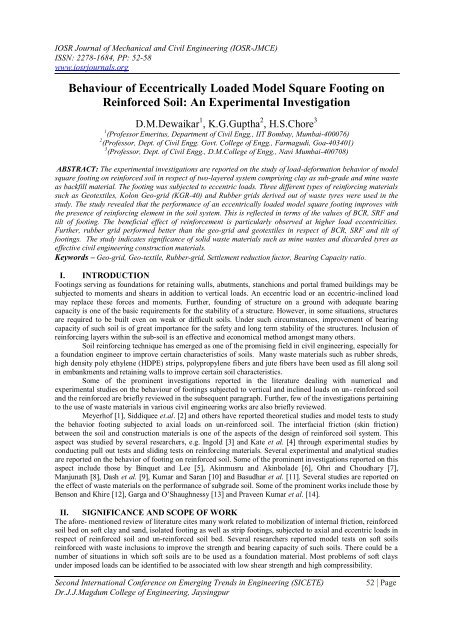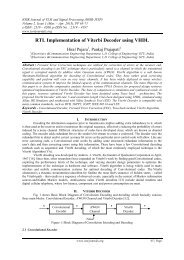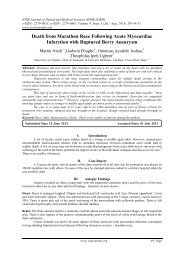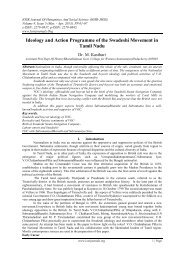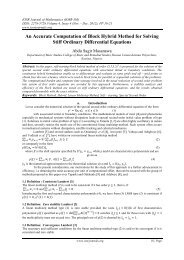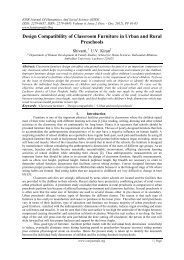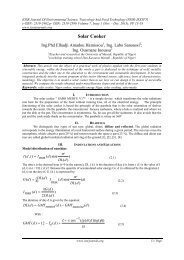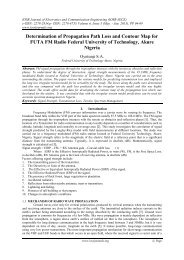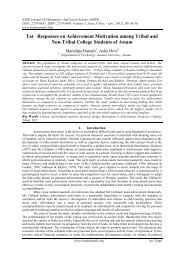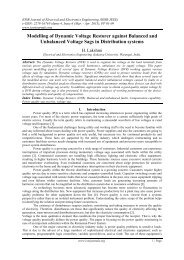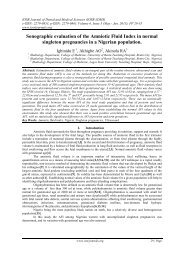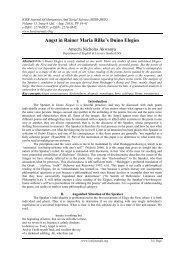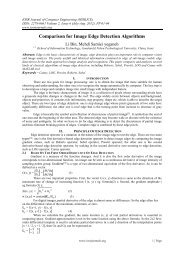Full PDF - IOSR
Full PDF - IOSR
Full PDF - IOSR
You also want an ePaper? Increase the reach of your titles
YUMPU automatically turns print PDFs into web optimized ePapers that Google loves.
<strong>IOSR</strong> Journal of Mechanical and Civil Engineering (<strong>IOSR</strong>-JMCE)<br />
ISSN: 2278-1684, PP: 52-58<br />
www.iosrjournals.org<br />
Behaviour of Eccentrically Loaded Model Square Footing on<br />
Reinforced Soil: An Experimental Investigation<br />
D.M.Dewaikar 1 , K.G.Guptha 2 , H.S.Chore 3<br />
1 (Professor Emeritus, Department of Civil Engg., IIT Bombay, Mumbai-400076)<br />
2 (Professor, Dept. of Civil Engg. Govt. College of Engg., Farmagudi, Goa-403401)<br />
3 (Professor, Dept. of Civil Engg., D.M.College of Engg., Navi Mumbai-400708)<br />
ABSTRACT: The experimental investigations are reported on the study of load-deformation behavior of model<br />
square footing on reinforced soil in respect of two-layered system comprising clay as sub-grade and mine waste<br />
as backfill material. The footing was subjected to eccentric loads. Three different types of reinforcing materials<br />
such as Geotextiles, Kolon Geo-grid (KGR-40) and Rubber grids derived out of waste tyres were used in the<br />
study. The study revealed that the performance of an eccentrically loaded model square footing improves with<br />
the presence of reinforcing element in the soil system. This is reflected in terms of the values of BCR, SRF and<br />
tilt of footing. The beneficial effect of reinforcement is particularly observed at higher load eccentricities.<br />
Further, rubber grid performed better than the geo-grid and geotextiles in respect of BCR, SRF and tilt of<br />
footings. The study indicates significance of solid waste materials such as mine wastes and discarded tyres as<br />
effective civil engineering construction materials.<br />
Keywords – Geo-grid, Geo-textile, Rubber-grid, Settlement reduction factor, Bearing Capacity ratio.<br />
I. INTRODUCTION<br />
Footings serving as foundations for retaining walls, abutments, stanchions and portal framed buildings may be<br />
subjected to moments and shears in addition to vertical loads. An eccentric load or an eccentric-inclined load<br />
may replace these forces and moments. Further, founding of structure on a ground with adequate bearing<br />
capacity is one of the basic requirements for the stability of a structure. However, in some situations, structures<br />
are required to be built even on weak or difficult soils. Under such circumstances, improvement of bearing<br />
capacity of such soil is of great importance for the safety and long term stability of the structures. Inclusion of<br />
reinforcing layers within the sub-soil is an effective and economical method amongst many others.<br />
Soil reinforcing technique has emerged as one of the promising field in civil engineering, especially for<br />
a foundation engineer to improve certain characteristics of soils. Many waste materials such as rubber shreds,<br />
high density poly ethylene (HDPE) strips, polypropylene fibers and jute fibers have been used as fill along soil<br />
in embankments and retaining walls to improve certain soil characteristics.<br />
Some of the prominent investigations reported in the literature dealing with numerical and<br />
experimental studies on the behaviour of footings subjected to vertical and inclined loads on un- reinforced soil<br />
and the reinforced are briefly reviewed in the subsequent paragraph. Further, few of the investigations pertaining<br />
to the use of waste materials in various civil engineering works are also briefly reviewed.<br />
Meyerhof [1], Siddiquee et.al. [2] and others have reported theoretical studies and model tests to study<br />
the behavior footing subjected to axial loads on un-reinforced soil. The interfacial friction (skin friction)<br />
between the soil and construction materials is one of the aspects of the design of reinforced soil system. This<br />
aspect was studied by several researchers, e.g. Ingold [3] and Kate et al. [4] through experimental studies by<br />
conducting pull out tests and sliding tests on reinforcing materials. Several experimental and analytical studies<br />
are reported on the behavior of footing on reinforced soil. Some of the prominent investigations reported on this<br />
aspect include those by Binquet and Lee [5], Akinmusru and Akinbolade [6], Ohri and Choudhary [7],<br />
Manjunath [8], Dash et al. [9], Kumar and Saran [10] and Basudhar et al. [11]. Several studies are reported on<br />
the effect of waste materials on the performance of subgrade soil. Some of the prominent works include those by<br />
Benson and Khire [12], Garga and O’Shaughnessy [13] and Praveen Kumar et al. [14].<br />
II. SIGNIFICANCE AND SCOPE OF WORK<br />
The afore- mentioned review of literature cites many work related to mobilization of internal friction, reinforced<br />
soil bed on soft clay and sand, isolated footing as well as strip footings, subjected to axial and eccentric loads in<br />
respect of reinforced soil and un-reinforced soil bed. Several researchers reported model tests on soft soils<br />
reinforced with waste inclusions to improve the strength and bearing capacity of such soils. There could be a<br />
number of situations in which soft soils are to be used as a foundation material. Most problems of soft clays<br />
under imposed loads can be identified to be associated with low shear strength and high compressibility.<br />
Second International Conference on Emerging Trends in Engineering (SICETE)<br />
Dr.J.J.Magdum College of Engineering, Jaysingpur<br />
52 | Page
Behaviour of Eccentrically Loaded Model Square Footing on Reinforced Soil: An Experimental Investigation<br />
The review, further, highlights relatively lesser work on reinforced soil technique using rubbergrids as<br />
reinforcing material in solving engineering problems associated with foundations on soft clays subjected to<br />
vertical centric and eccentric loads. On the backdrop of the need to understand the behaviour of rubber<br />
reinforced system, an experimental investigation was conducted on the model footings reinforced with<br />
rubbergrid, Dewaikar et al. [15] reported the study of load deflection behaviour of model square and circular<br />
footings, under un-reinforced and reinforced conditions in respect of a two-layered system, consisting of clay as<br />
sub-grade and mine waste as backfill material, under the application of vertical centric loads.<br />
Kolon geogrid KGR-40, non woven geotextile GPB-203 (Sri Dinesh Mills, Vadodara) and rubbergrids<br />
derived out of waste tyres (Fig. 1) were used as single layer reinforcements soft sub-grade to control settlement<br />
were investigated in the studies. The width and depth of the reinforcing materials were varied to determine their<br />
effects on the settlement and bearing capacity ratios. The results on rubber grids showed that, there is significant<br />
difference in the contribution of increase in bearing capacity ratios and settlement reduction factors as compared<br />
to the other reinforcing elements.<br />
Along similar lines, The load-deformation behavior of a model square footing under un-reinforced and<br />
reinforced conditions in respect of a two-layered system, consisting of clay as sub-grade and mine waste as<br />
backfill material, under the application of eccentric loads along one axis of the footing is reported in this paper.<br />
In view of this, an experimental investigation was conducted on the soft soil reinforced with geotextiles, geogrid<br />
and rubber grid.<br />
III. MATERIALS AND METHODOLOGY OF INVESTIGATION<br />
Experimental Programme<br />
The experimental programme included a series of model footing tests on two layered soil system. Model mild<br />
steel plates of square and circular shapes with thickness 20 mm were used and following aspects were studied.<br />
• Shape of footing: Square (120 mm × 120 mm)<br />
• Eccentricity of the applied load (e): 0.00B, 0.1 B, 0.2 B and 0.3 B (B being the width / diameter of<br />
model footing)<br />
• Thickness of the granular layer (H): 0.25 B, 0.375 B and 0.5 B<br />
• Width of the reinforcement (B’): 2 B, 4 B and 6B<br />
• Type of reinforcement: Geotextile, Geo-grid and Rubber-grid (Fig.1)<br />
Geotextile Geogrid Rubbergrid<br />
Fig. 1: Different reinforcement used in the study<br />
Test Tank Details<br />
Tests were conducted in a tank (1000 mm × 1000 mm × 1000 mm) fabricated out of 8 mm thick M.S. plates.<br />
Load was applied through a load cell of 50 kN capacity, attached to a hydraulic jack and it was operated through<br />
a hydraulic power pack of 75 kN capacity. A load and displacement indicator unit facilitated reading the applied<br />
load and displacement of footing at any instant of time to an accuracy of 10 N. Three linear variable differential<br />
transformers (LVDT) were used to record settlements of the footing (Fig.2). The model footings (120×120×20<br />
mm) were placed on air-dried (un-reinforced and reinforced) mine waste, compacted to a relative density of<br />
78.85% on clay sub-grade of wet density 1.768 gm/cc with 88% degree of saturation. Footings were subjected to<br />
vertical eccentric loads.<br />
The schematic of the model footings (cross-section and plan) is shown in Fig.2. The physical properties<br />
of soils are reported in Table 1 and 2. The description and properties of the reinforcements are reported in Table<br />
3 -5.<br />
Second International Conference on Emerging Trends in Engineering (SICETE)<br />
Dr.J.J.Magdum College of Engineering, Jaysingpur<br />
53 | Page
Behaviour of Eccentrically Loaded Model Square Footing on Reinforced Soil: An Experimental Investigation<br />
Hydraulic jack<br />
Display<br />
indicator<br />
Load indicator<br />
Trolly<br />
Hyd. power<br />
pack<br />
Loading frame<br />
Model footing<br />
Load cell<br />
LVDT<br />
Mine waste<br />
Reinforcement<br />
Subgrade - clay<br />
Test tank<br />
Water outlet<br />
Concrete platform<br />
Fig.2 Details of test tank<br />
Table 1: Properties of processed mine waste<br />
Sp. Gravity 2.65<br />
Max. Density (gm/ cc) 1.48<br />
Min. Density (gm/ cc) 1.165<br />
Rel. density achieved in tank (%) 78.85<br />
E 0.892<br />
e max 1.274<br />
e min 0.790<br />
Angle of int. friction (degrees) 35.5<br />
Density achieved in tank (gm/cc) 1.4<br />
Table 2: Properties of silty clay subgrade<br />
Bulk density (gm/ cc) 1.720<br />
Dry density (gm/cc) 1.33<br />
Specific gravity 2.619<br />
Liquid limit (%) 45.75<br />
Plastic limit (%) 33.09<br />
Plasticity index (%) 12.66<br />
Un-drained cohesion (kPa) 33.5<br />
Table 3: Properties of Geo-grid KGR-40<br />
Property/ Item<br />
Material<br />
Specification<br />
PET<br />
Weight (gm/ m 2 ) 280<br />
Aperture size ± 5 % 20/ 22<br />
Tensile Strength (kN/m)<br />
@ 5 % Strain<br />
@ break<br />
14/6<br />
40/20<br />
Elongation (%)
Behaviour of Eccentrically Loaded Model Square Footing on Reinforced Soil: An Experimental Investigation<br />
Light weight<br />
Yes<br />
Non biodegradable<br />
Yes<br />
Material<br />
SBR<br />
Tensile strength at break (kN) 0.11*<br />
Elongation at break (%) 45<br />
*Applied strain rate 6 mm/ min<br />
Table 5: Properties of Geotextile<br />
MAKE: Non- woven needle punched geotextile,<br />
Manufactured by: Shri Dinesh Mills, Vadodara, Gujrat (India)<br />
Type GPB 203<br />
Material Composition<br />
Polypropylene<br />
Weight (g/m 2 ) 225<br />
Thickness (mm) 2<br />
Breaking Strength (kg)<br />
Warp away<br />
Weft away<br />
30<br />
60<br />
Breaking elongation (%) 80-110<br />
Water Permeability (wt/m 2 /sec at lower head) 140<br />
Micron Size (wet sieving method) 30<br />
Mullen Bursting Strength (kg/cm 2 ) 15<br />
IV. RESULTS AND DISCUSSION<br />
Pressure- settlement characteristics were obtained from various tests. The tests were conducted till failure and<br />
corresponding load and settlement were recorded. The terms Bearing Capacity Ratio (BCR) and Settlement<br />
Reduction Factor (SRF) are used for convenience to interpret the test data. The tests were conducted for three<br />
different values of H/B ratios such as 0.25, 0.375 and 0.5.<br />
BCR = q/q o and SRF = (S/B) r / (S/ B) o<br />
where,<br />
q o = average contact pressure of footing for un-reinforced soil at failure<br />
q = average contact pressure for reinforced soil at failure<br />
(S/B) r = settlement ratio for reinforced soil and at failure<br />
(S/B) o = settlement ratio for un-reinforced soil and at failure<br />
H = thickness of mine waste layer<br />
B = footing width<br />
B’ = reinforcement width<br />
It is observed that the maximum ultimate bearing pressure is obtained in case of H/B = 0.375. This is considered<br />
as the critical H/B ratio. Tests were conducted for eccentric loads along one axis of the footing in respect of unreinforced<br />
and reinforced cases with e/B ratios such as 0.1, 0.2 and 0.3. The thickness of mine waste layer<br />
corresponded to (H/B)cr, for both reinforced and un-reinforced systems and the width of reinforcement<br />
corresponded to the optimum value B/B’. For the determination of ultimate bearing pressure (UBP) of an<br />
eccentrically loaded footing, the concept of useful width has been considered. As per this concept, portion of the<br />
footing which is symmetrical about the load is considered useful and other portion is simply assumed<br />
superfluous for the convenience of computations. Settlement under the load is computed by the method of<br />
interpolation, knowing the settlements at the centre and at known distances from the edges of the footing.<br />
Un-reinforced Case<br />
The pressure- settlement characteristics as obtained for various load eccentricities are shown in Table 6. The<br />
characteristics show a gradual increase in settlement till failure, which is indicated by suddenly increased<br />
settlements with further incremental loading. A bulge formation was noticed on the side of the eccentricity and<br />
volume of this bulge increased with increasing eccentricity.<br />
Table 6: Comparison of ultimate bearing pressure (UBP) and settlements<br />
Eccentricity UBP (kPa) Settlement<br />
(e/B)<br />
(mm)<br />
0.0B 190 17.8<br />
0.01B 164 18<br />
0.02B 105 18.4<br />
0.03B 85 18.8<br />
Second International Conference on Emerging Trends in Engineering (SICETE)<br />
Dr.J.J.Magdum College of Engineering, Jaysingpur<br />
55 | Page
Settlement (mm)<br />
Behaviour of Eccentrically Loaded Model Square Footing on Reinforced Soil: An Experimental Investigation<br />
Similarly, the values of the angle of tilt at failure for various load eccentricities in respect of a model<br />
square are shown in Table 7. The pressure- tilt relationships for various eccentricities of applied loads indicates<br />
that, with increase in load eccentricity, angle of tilt increases, ultimate bearing pressure decreases and also,<br />
pressure- tilt curve turns linear.<br />
Table 7: Variation of angle of tilt at failure<br />
Eccentricity (e/B) Angle of tilt<br />
0.0B 0.0<br />
0.01B 7.5<br />
0.02B 11<br />
0.03B 14<br />
Reinforced Case<br />
In respect of the tests under reinforced condition, pressure settlement characteristics were obtained to<br />
optimize the thickness of backfill material required on clay sub-grade and width of reinforcement. The<br />
performance of various reinforcements was also evaluated.<br />
Effect of reinforcement on BCR<br />
A typical pressure-settlement relationships for a load eccentricity (e/B= 0.1) and corresponding to a<br />
critical case are shown in Figure 3, respectively for all the reinforcements. Similarly, the UBP, BCR and SRF<br />
values for various eccentricities at critical value of H/B ratio is shown in Table 8.<br />
0<br />
2<br />
4<br />
6<br />
8<br />
10<br />
12<br />
14<br />
16<br />
18<br />
20<br />
Bearing Pressure (kPa)<br />
0 100 200 300 400 500 600<br />
e=0.1B<br />
Unreinforced<br />
Geogrid<br />
Rubbergrid<br />
Geotextiles<br />
Fig.3: Pressure – settlement relationships for e/B =0.1<br />
Table 8: UBP, BCR and SRF values for a reinforced case<br />
e/B UBP (kPa) % increase in UBP BCR SRF<br />
UR GT GG RG GT GG RG GT GG RG GT GG RG<br />
0.0 190 480 520 570 152 173 200 2.52 2.73 3.00 0.92 0.89 0.83<br />
0.1 164 434 487 540 164 195 229 2.65 2.96 3.29 0.971 0.942 0.859<br />
0.2 105 311 386 405 196 268 286 2.96 3.68 3.86 0.988 0.946 0.886<br />
0.3 85 290 340 380 241 300 347 3.41 4.00 4.47 0.991 0.949 0.892<br />
All the tests were conducted with the centroid of reinforcing elements in line with the applied load. The<br />
ultimate bearing pressure is found to reduce with the increase in the eccentricity of load in all the cases. At the<br />
same time, the settlement of footing is observed to increase with increase in eccentricity for a given pressure.<br />
However, for any specified load eccentricity and for a given load, the settlement in case of a reinforced system<br />
is considerably less than that in case of un-reinforced system.<br />
The results indicate that, the provision of a reinforcement layer at the interface of the mine waste and<br />
clay, results in an increase in the ultimate bearing pressure by 164%, 196%, and 241%, respectively for e/ B =<br />
0.1, 0.2 and 0.3 in case of geo-textile, 195%, 268% and 300% in case of geo-grid and 29%, 286% and 347% in<br />
case of rubber-grid as compared to the un-reinforced cases.<br />
It is further observed that, the rubber grid yields 39.63%, 46.66% and 43.98% more bearing pressure at<br />
e/ B = 0.1, 0.2 and 0.3, respectively than geotextiles. The corresponding values in case of geogrid are 17.43%,<br />
6.72% and 15.66%, respectively. This may also be due to the fact that, placement of centriod of reinforcement in<br />
line with the applied load, brings a large part of the reinforcement in the zone of soil deformation, thus allowing<br />
a better utilization of its tensile strength.<br />
It is further observed that, the BCR improves with increasing load eccentricity. In other words, it<br />
means that, provision of reinforcement has more beneficial effect at higher load eccentricities. For both the<br />
footings the geo-grid is found to perform better than geotextile and rubber-grid is found to perform better than<br />
geo-grid in respect of BCR.<br />
Second International Conference on Emerging Trends in Engineering (SICETE)<br />
Dr.J.J.Magdum College of Engineering, Jaysingpur<br />
56 | Page
Angle of Tilt(Degrees)<br />
Behaviour of Eccentrically Loaded Model Square Footing on Reinforced Soil: An Experimental Investigation<br />
The values of the BCR are observed to be 3.29, 3.86 and 4.47, respectively corresponding to e/ B<br />
values of 0.1, 0.2 and 0.3 in case of rubber-grid. These are higher by 24.15%, 30.40% and 31.08% as compared<br />
to that in respect of geotextile and by 11.14%, 4.89% and 11.75% as compared to that in respect of geo-grid. It<br />
is observed that the rubber-grid proves to be more efficient as compared to other reinforcing elements in respect<br />
of BCR.<br />
Effect of reinforcement on settlement<br />
It is observed that, there is a considerable reduction in the settlement in case of reinforced system as compared<br />
to the un-reinforced one. The values of the settlement reduction factor (SRF) are observed to increase with the<br />
increase in the eccentricity of load in respect of all the reinforcements. The values of the SRF are found to be<br />
0.859, 0.886 and 0.892, respectively corresponding to e/B values of 0.1, 0.2 and 0.3 in case of rubber-grid.<br />
These are lower by 13.03%, 11.51% and 11.09% as compared to that in respect of geotextile; and by 9.66%,<br />
6.78% and 6.39% as compared to that in respect of geo-grid. Thus, the results indicate that rubber grid is more<br />
effective in terms of improvement in settlement.<br />
Effect of reinforcement on tilt<br />
A typical pressure - tilt relationships for a load eccentricity (e/B =0.1) corresponding to critical case are shown<br />
in Fig. 4. Similarly, the values of the angle of tilt and corresponding percentage reduction in tilt for reinforced<br />
critical case at different eccentricities are shown in Table 9.<br />
0<br />
1<br />
2<br />
3<br />
Bearing Pressure (kPa)<br />
0 100 200 300 400 500 600<br />
e=0.1B<br />
Unreinforced<br />
Geogrid<br />
Rubbergrid<br />
Geotextiles<br />
4<br />
5<br />
6<br />
7<br />
8<br />
Fig.4: Pressure – tilt relationships (Square footing)<br />
It is observed that, for any specified load eccentricity, there is a considerable reduction in the angle of<br />
tilt in case of reinforced system as compared to the un-reinforced one in respect of either footing. A reduction<br />
of 36%, 33% and 17% in tilt is observed for eccentricity ratios of 0.1, 0.2 and 0.3, respectively in case of<br />
geotextile when compared with the un-reinforced case at failure. The corresponding values in case of geo-grid<br />
and rubber-grid are 50%, 57% and 40%; and 56%, 69% and 47%, respectively. This shows that rubber-grid<br />
proves to be more efficient in the reduction of tilt of the footing in comparison to the other reinforcing elements.<br />
Table 9: Reduction in tilt for reinforced critical case at failure (Reinforced case)<br />
e/B<br />
Square footing<br />
Angle of tilt<br />
% reduction in tilt<br />
UR GT GG RG GT GG RG<br />
0.0 0.0 0.0 0.0 0.0 - - -<br />
0.1 7.5 5.5 5 4.8 36 50 56<br />
0.2 11 8.25 7 6.5 33 57 69<br />
0.3 14 12 10 9.5 17 40 47<br />
The above results clearly show that, rubber grid is more effective in terms of the improvement in bearing<br />
pressure, reduction in settlement and angle of tilt than the other two reinforcements. The superior performance<br />
of the rubber grid may be attributed to better frictional adherence between the longitudinal members of the grid<br />
and soil which is influenced by the surface properties and coefficient of friction between them. The nylon belt<br />
provided within the tread and sidewalls of the tyre remains protruded even after stripping (Fig.5).<br />
Fig. 5: Typical radial passenger tyre construction<br />
Second International Conference on Emerging Trends in Engineering (SICETE)<br />
Dr.J.J.Magdum College of Engineering, Jaysingpur<br />
57 | Page
Behaviour of Eccentrically Loaded Model Square Footing on Reinforced Soil: An Experimental Investigation<br />
This helps in creating the desired roughness in the rubber grid and in turn develops greater frictional<br />
resistance, although its tensile strength is less than that of geo grid. Semi- elastic properties of rubber grid<br />
develop better pseudo- cohesion owing to the temporary deformation of rubber grid. However, this mechanism<br />
is not present in case of other conventional grids. Moreover, the apertures present in the grid structure, there are<br />
chances for better interlocking of the sub-grade and the reinforcement along with the backfill material. Hence,<br />
the performance of grids is better than that of geo-textile.<br />
V. SUMMARY AND CONCLUSIONS<br />
Some of the broad conclusions emerged from the present study are as under:<br />
i. Provision of reinforcement results in enhancement of ultimate bearing pressure and bearing capacity<br />
ratio (BCR). This enhancement is more for higher load eccentricities as compared to the lower ones,<br />
thus showing beneficial effects of the reinforcement.<br />
ii. Reduction in settlement on provision of reinforcement, shows a decreasing trend, i.e., settlements are<br />
more at higher load eccentricities.<br />
iii. Performance of rubber grid is superior to the other two reinforcements, both in terms of bearing<br />
capacity ratio (BCR) and settlement reduction, with geotextile being the least effective.<br />
iv. Optimum width of reinforcement (B’) for deriving maximum possible BCR is about 4B in case of all<br />
the reinforcements and for both the footings.<br />
v. With geo-synthetic reinforcement, the critical value of H/B ratio corresponding to maximum BCR is<br />
about 0.375 for all reinforcing elements.<br />
vi. Rubber reinforcement probes to be more economical and effective soil reinforcing elements.<br />
The performance of eccentrically loaded model square footing improves with the presence of<br />
reinforcing element in the soil system. This is reflected in terms of the values of BCR, SRF and tilt of footing.<br />
The beneficial effect of reinforcement is particularly observed at higher load eccentricities as shown by the<br />
increasing values of BCR. The better performance of rubber grid could be a cheaper and viable alternative for<br />
effective ground improvement. The study underscores the effective utilization of the solid wastes generated in<br />
the process of mining in conjunction with the rubber wastes as civil engineering construction materials.<br />
REFERENCES<br />
[1] Mayerhof, G.G., “The Ultimate Bearing Capacity of Foundations on Slopes”, Proc. 4 th International Conference on Soil<br />
Mechanics and Foundation Engineering, 1, 1957, 384-386.<br />
[2] Siddiquee, M.S.A., Tatsuoka, F. and Tanaka, T, “Model Tests and FEM Simulation of Some Factors affecting Bearing Capacity<br />
of a Footing on Sand”, Soils and Foundation, 4(2) . 2001,53-76.<br />
[3] Ingold, T.S., “Some Observations on the Laboratory Measurement of Soil Geotextile Bond”, Geotechnical Testing Journal,<br />
ASTM, 5 (3), 1982, 57-67.<br />
[4] Kate, J.M., Rao, G.V., and Tyagi, S.K., “Evaluation of Soil Reinforcement Friction”, Indian Geotechnical Journal, 18 (2), 1988,<br />
153-160.<br />
[5] Binquet, J. and Lee, K.H., “Bearing Capacity Analysis of Reinforced earth Slab”, Journal of Getechnical Engineering, ASCE,<br />
101, 1975,1251-1276.<br />
[6] Akinmusru, J. O. and Akinbolade, J.A., “Stability of Loaded Footings on Reinforced Soil”, Journal of Geotechnical Engineering,<br />
ASCE, 107 (GT-6), 1981,819-827.<br />
[7] Ohri, M.L. and Choudhari, G.R., “Pressure- Settlement Behaviour of Reinforced Dune Sand”, Proc. Indian Geotechnical<br />
Conference, Surat, 1991, 335-358.<br />
[8] Manjunath, V.R, “Stress Deformation Behaviour and Bearing Capacity of Geofabric Reinforced Soils”, Ph.D. Thesis Submitted<br />
to IIT Bombay (Unpublished), 1995.<br />
[9] Dash, S.K., Krishnaswamy, N.R., and Rajgopal, K., “Bearing Capacity of Strip Footings Supported on Geocell Reinforced<br />
Sand”, Geotextiles and Geomembranes, 19 (4), 2001, 235-256.<br />
[10] Kumar, A. and Saran, S., “Closely Spaced Footings on Geo-grid Reinforced Sand”, Journal of Geotechnical and Geoenvironmental<br />
Engineering, ASCE, 129 (7), 2003, 660-664.<br />
[11] Basudhar, P.K., Saha, S. and Deb, K., “Circular Footings resting on Geotextile Reinforced Sand Bed”, Geotextiles and<br />
Geomembranes, 25 (6), 2007, 377-386.<br />
[12] Benson, C. and Khire, M., “Soil Reinforcement with Strips of Reclaimed HDPE”, Journal of Geotechnical Engineering, ASCE,<br />
120 (5), 1994, 838-855.<br />
[13] Garga, V.K. and O’ Shuaghnessy, V., “Tyre Reinforced Earth Fill –I, II and III”, Canadian Geotechnical Journal, Vol. 37, 2000,<br />
75-131<br />
[14] Kumar, P., Mehndiratta, H.C. and Durga Rao, A.K., “Use of Polythene in Fly Ash Soil Embankments”, Proceedings National<br />
Symposium on Advances in Geotechnical Engineering, IISc Banglore, 2004, 279-284<br />
[15] Dewaikar, D.M., Guptha, K.G. and Chore, H.S., “Use of Tyre wastes into an Experimental Study of Model Footings on<br />
Reinforced Soil”, Journal of Structural Engineering, 38 (1), 2011, 84-93<br />
Second International Conference on Emerging Trends in Engineering (SICETE)<br />
Dr.J.J.Magdum College of Engineering, Jaysingpur<br />
58 | Page


